
Hans Aichinger LEERE TIEFE
Leipzig 22 Apr – 3 Jun 2023
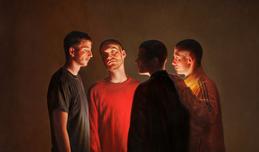
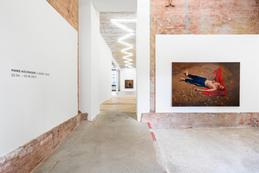
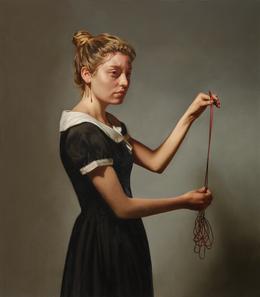
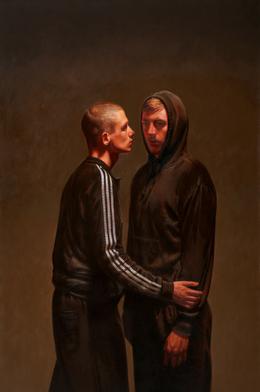
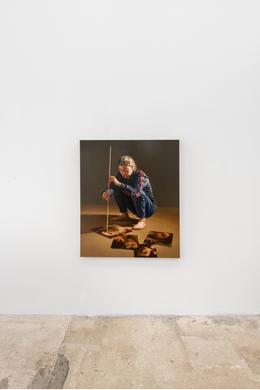
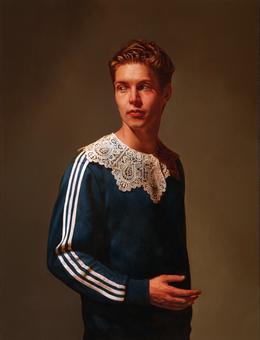
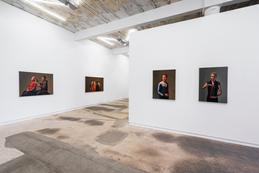
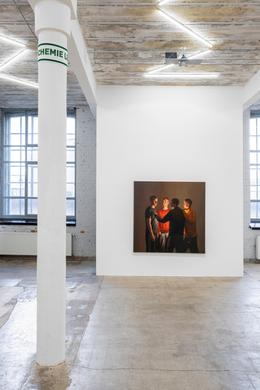
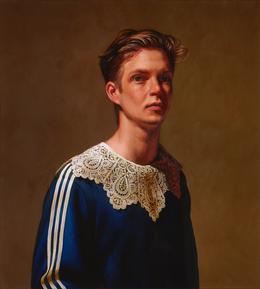
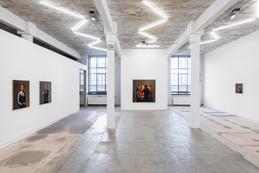
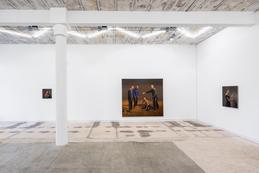
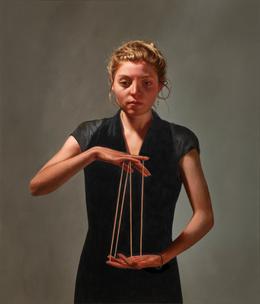
Pneuma (Hans Aichinger’s People)
I
The Hüterin (the guardian) is sitting on a box. The box appears to be empty, where is the guardian looking? Kokoschka’s hands are Hans Aichinger’s eyes.
The inside of the box, which the guardian is sitting on, is partially hidden in shadow, wooden sticks protrude from the box at ground level, like the sticks that the Saxonian poet Wofgang Hilbig has a child figure knock together, continually knock together, in his labyrinthine story Old Knacker’s Yard. In Hilbig’s story the wanderer loses his way along a little river that brings him deeper into the past and ruins, wandering through times and spaces, glimpsing “puddles or ponds”, collapsed shafts and factory complexes which have filled with water. “… when the jackdaws and owls jumped more cautiously and nervously from window to window amongst the ruins, when the moons rolled quicker, when the nocturnal clouds circled faster under the vortex of the stars: to which they looked up, the water eyes, stoic and resigned, peeking out of the landscape, full of a knowledge of things past, which were thought to be buried; they gazed tired, dark and deep, not speaking of the battles…”
Aichinger’s prophet does not speak of the battles, his gaze is also mute, drawing us into a mystery, his finger raised like a small thin stick, the tip of one of the pieces of timber that protrudes from the inside of the box, on which the guardian sits. No “stick fencing", as Hilbig calls it. Instead: “Even though I walk through the valley of the shadow of death, / I will fear no evil, / for you are with me, / thy rod and thy staff they comfort me.”
When we looked into the darkness as children, like one of Aichinger’s people (no forms, no figures, no images and overexposures: people, but maybe more about that later) looking into the guardian’s box, on which the guardian no longer crouches, we were inevitably frightened, the fear always arose (there is a light, that never goes out); in a dream the child, that at some point began to say I “and even though I walk through the valley of the shadow of death", was trapped in an ash bin, one of those metallic grey buckets of socialist manufacture, on whose lid a witch crouches, who bears no similarity to Aichinger’s guardian, but paradoxically was faceless, could be anyone and everything, but nevertheless pressed the lid down with a leaden weight, so that the child crouched together in fear could hardly breath inside the bin.
The guardian is the guardian of fear, the prophet gazes into emptiness with tired eyes, gazes into nothingness, who Aichinger defends against the void, in which he will place the soul, a thin, slender light which hovers permanently above the heads of his people, sometimes visible, sometimes invisible…
II
The light above a thorn bush, fire above a thorn bush, that has become transformed into the glitter of pyrotechnics, that the prophet appears to conduct with two hands, no, just with his eyes, the movements of his eyes (Aichinger’s eyes are Kokoschka’s hands), the prophet, who is carried into the Georg-Schwarz-Sportpark in Leipzig-Leutzsch by SPIRIT (pneuma), placed on a stage, in front of a fog-brown wall of planks, earth or air, what is it, matter?, in a depopulated world, for the stadium is empty,
but just for a short moment, then it fills up again, the prophet raises his finger, feels his wounds, visible and invisible, illuminating the supposed lights of the soul, which this time are just the sparklers of the once-again children, chants, which lay themselves like a dome above the circle of the stadium, “Chemie, Chemie, there’s only one Chemie”, let there be lights in the vault of the sky, ever more chants and songs, because form is order, form begets form, as form resists every norm, as form connects the abstract with supposed realism, as form burns itself into backgrounds, as form deforms and is sometimes just pretext (and Jeeeesus sits on the rear bench and waves because he knows he is contained in every ever so Düreresque rabbit) as form is composition, as form is always the subject at the beginning of the sentence, which is also its end, RED WHITE ESSEN VS BLACK WHITE ESSEN, "don’t eat, drink!”, shouts the prophet from the grandstand of the Georg-Schwarz-Sportpark, named after the communist and resistance fighter Georg Schwartz, who was murdered by the Nazis at the beginning of 1945.
Minute of silence. And Hans Aichinger’s people also remain silent. Moving their eyelids as if in slow motion, lifting, almost somnambulistic, their hands, fingers, bowing and freezing in time. In Aichinger’s works time is a mystery, which is not to be deciphered, Jesus wears an Adidas jacket and the old staffs and sticks of the wanderer and searcher and sage reappear in today. The disciplines bow before one-another. WHERE ARE WE?
Didn’t the people three thousand years ago think they were acting on a kind of stage, in the background the earth-colored time, above them the gods or the god…? WHERE ARE WE?
Aichinger’s geometric dream constellations; figures, that persist in the stream of time, the prophet stands on the grandstand of the Georg-Schwarz-Sportpark in Leipzig Leutzsch, which since 1993 has been called the Alfred-Kunze-Sportpark, named after the trainer Alfred Kunze, who led the BSG Chemie Leipzig, the so-called “leftovers of Leipzig“ to championship victory against the overpowering Sportclubs in 1964. Old Masters, in poetry there is (there was), similar to painting, a Saxonian school of poetry, although no one really knew what actually united them. Was it a precision of form? The reference to something like sonnets? The references to mythology and antiquity?
III
In 1958 a daughter of Georg Schwarz married the (infamous) cultural functionary Alfred Kurella, who is alleged to have denounced his own brother during the Great Purge in Moscow. Kurella had to hold out in the Soviet Union for four years after the end of the war, somewhere in the Urals, that magnetic border between…, had to hold out, because this was normal, when one was too deeply entangled in intelligence service matters. What did he do during this time? Did he question his prophets? Did he look over the peaks of the mountains in search of God, only finding Stalin? Persisting in solitude, persisting in silence. The didactician Kurella, who long denied the primordial substance of art, but then finally acknowledged it, because the eternal “Wherefore literature, wherefore art?” did not permit any didactic answers, the class struggle had been fought out, the victims were immense, maybe he also dreamed of withdrawing to a cave, painting the walls, nothing else…
Kurella was one of the founders of the Institute for Literature “Johannes R. Becher” in Leipzig. Today the successor to the Becher institute is located opposite the Academy of Fine Arts Leipzig, where Aichinger was active as both a student and as a teacher. Teacher and pupil? Student? The attempt to institutionalize art is always just a pretext, hopefully still is and always will be a pretext, to facilitate encounters, to bring artists together, who, by all means, can also teach, can learn, can grasp, can pass on, that without the foundation of the Old Masters (so yes!) modernity is not possible, that traces of a modernity can already be recognized amongst the Old Masters (we mean the forever young painters of history, the old and, at the time, new artists, we look back hundreds of years, already almost a thousand, who wants to be a master, when he is repeatedly the magician’s apprentice, that floods everything…), who likewise gazed searchingly into the sky, who looked over the mountains; traces of a modernity. I wouldn’t be surprised if it were soon discovered that one of the people on the canvas in one of the pictures in the Prado was now (suddenly or always had been) wearing an Adidas jacket (the correct conjunctive doesn’t play a role here, it is about Sound). “Adidas makes trousers wet”, sing the children, “Puma socks make them dry again!”
Are we in a cave? Walls, brown and earthy. Are those shadows on the walls? What do Aichinger’s people see on the walls? Plato’s pneuma.
The old philosopher also raised his finger, however he wore a thick white beard, which Aichinger’s Man who sold the world will grow in the future, where at the moment there is only a thin line visible above the upper lip…
A shadow falls in the cave, falls on the boy who is standing in front of one of the cave walls. It is the shadow from the wooden sticks lodged in his breast that falls on his naked chest. No blood. No allegory. Plato enters the cave he created and described, he is young again and is wearing an Adidas jacket. WE SHOULD PLAY MORE SKAT AGAIN! Ace of spades means death, but also return. EVERYONE SHOULD PLAY SKAT TOGETHER AGAIN, SIMPLY PLAY SKAT! Longing for simplicity.
In skat we find logos but also chance. Luck. Crime and punishment. Proletarian dreams…
In order for the logos to operate it was materialized through “fire”. When the “fire” unites with the “air”, a further primary substance, then this forms a warm breath or pneuma. With Aichinger this breath becomes visible. It positively glows around his people.
One of these people, a young woman, carries a kind of tea bowl on her head, a chalice, and the blood drops into it, invisible. Just as the wounds are also invisible.
Or does the chalice serve to capture the breath?
If we were to look up at the sky, which here is the roof of the cave, then we would have to tilt back our head, would spill everything. So: “Eyes front! At ease!” “
Clemens Meyer, 2023
A number of the works from Hans Aichinger mentioned in the text were produced in the recent past, immediately prior to the works displayed in the exhibition.
I
The Hüterin (the guardian) is sitting on a box. The box appears to be empty, where is the guardian looking? Kokoschka’s hands are Hans Aichinger’s eyes.
The inside of the box, which the guardian is sitting on, is partially hidden in shadow, wooden sticks protrude from the box at ground level, like the sticks that the Saxonian poet Wofgang Hilbig has a child figure knock together, continually knock together, in his labyrinthine story Old Knacker’s Yard. In Hilbig’s story the wanderer loses his way along a little river that brings him deeper into the past and ruins, wandering through times and spaces, glimpsing “puddles or ponds”, collapsed shafts and factory complexes which have filled with water. “… when the jackdaws and owls jumped more cautiously and nervously from window to window amongst the ruins, when the moons rolled quicker, when the nocturnal clouds circled faster under the vortex of the stars: to which they looked up, the water eyes, stoic and resigned, peeking out of the landscape, full of a knowledge of things past, which were thought to be buried; they gazed tired, dark and deep, not speaking of the battles…”
Aichinger’s prophet does not speak of the battles, his gaze is also mute, drawing us into a mystery, his finger raised like a small thin stick, the tip of one of the pieces of timber that protrudes from the inside of the box, on which the guardian sits. No “stick fencing", as Hilbig calls it. Instead: “Even though I walk through the valley of the shadow of death, / I will fear no evil, / for you are with me, / thy rod and thy staff they comfort me.”
When we looked into the darkness as children, like one of Aichinger’s people (no forms, no figures, no images and overexposures: people, but maybe more about that later) looking into the guardian’s box, on which the guardian no longer crouches, we were inevitably frightened, the fear always arose (there is a light, that never goes out); in a dream the child, that at some point began to say I “and even though I walk through the valley of the shadow of death", was trapped in an ash bin, one of those metallic grey buckets of socialist manufacture, on whose lid a witch crouches, who bears no similarity to Aichinger’s guardian, but paradoxically was faceless, could be anyone and everything, but nevertheless pressed the lid down with a leaden weight, so that the child crouched together in fear could hardly breath inside the bin.
The guardian is the guardian of fear, the prophet gazes into emptiness with tired eyes, gazes into nothingness, who Aichinger defends against the void, in which he will place the soul, a thin, slender light which hovers permanently above the heads of his people, sometimes visible, sometimes invisible…
II
The light above a thorn bush, fire above a thorn bush, that has become transformed into the glitter of pyrotechnics, that the prophet appears to conduct with two hands, no, just with his eyes, the movements of his eyes (Aichinger’s eyes are Kokoschka’s hands), the prophet, who is carried into the Georg-Schwarz-Sportpark in Leipzig-Leutzsch by SPIRIT (pneuma), placed on a stage, in front of a fog-brown wall of planks, earth or air, what is it, matter?, in a depopulated world, for the stadium is empty,
but just for a short moment, then it fills up again, the prophet raises his finger, feels his wounds, visible and invisible, illuminating the supposed lights of the soul, which this time are just the sparklers of the once-again children, chants, which lay themselves like a dome above the circle of the stadium, “Chemie, Chemie, there’s only one Chemie”, let there be lights in the vault of the sky, ever more chants and songs, because form is order, form begets form, as form resists every norm, as form connects the abstract with supposed realism, as form burns itself into backgrounds, as form deforms and is sometimes just pretext (and Jeeeesus sits on the rear bench and waves because he knows he is contained in every ever so Düreresque rabbit) as form is composition, as form is always the subject at the beginning of the sentence, which is also its end, RED WHITE ESSEN VS BLACK WHITE ESSEN, "don’t eat, drink!”, shouts the prophet from the grandstand of the Georg-Schwarz-Sportpark, named after the communist and resistance fighter Georg Schwartz, who was murdered by the Nazis at the beginning of 1945.
Minute of silence. And Hans Aichinger’s people also remain silent. Moving their eyelids as if in slow motion, lifting, almost somnambulistic, their hands, fingers, bowing and freezing in time. In Aichinger’s works time is a mystery, which is not to be deciphered, Jesus wears an Adidas jacket and the old staffs and sticks of the wanderer and searcher and sage reappear in today. The disciplines bow before one-another. WHERE ARE WE?
Didn’t the people three thousand years ago think they were acting on a kind of stage, in the background the earth-colored time, above them the gods or the god…? WHERE ARE WE?
Aichinger’s geometric dream constellations; figures, that persist in the stream of time, the prophet stands on the grandstand of the Georg-Schwarz-Sportpark in Leipzig Leutzsch, which since 1993 has been called the Alfred-Kunze-Sportpark, named after the trainer Alfred Kunze, who led the BSG Chemie Leipzig, the so-called “leftovers of Leipzig“ to championship victory against the overpowering Sportclubs in 1964. Old Masters, in poetry there is (there was), similar to painting, a Saxonian school of poetry, although no one really knew what actually united them. Was it a precision of form? The reference to something like sonnets? The references to mythology and antiquity?
III
In 1958 a daughter of Georg Schwarz married the (infamous) cultural functionary Alfred Kurella, who is alleged to have denounced his own brother during the Great Purge in Moscow. Kurella had to hold out in the Soviet Union for four years after the end of the war, somewhere in the Urals, that magnetic border between…, had to hold out, because this was normal, when one was too deeply entangled in intelligence service matters. What did he do during this time? Did he question his prophets? Did he look over the peaks of the mountains in search of God, only finding Stalin? Persisting in solitude, persisting in silence. The didactician Kurella, who long denied the primordial substance of art, but then finally acknowledged it, because the eternal “Wherefore literature, wherefore art?” did not permit any didactic answers, the class struggle had been fought out, the victims were immense, maybe he also dreamed of withdrawing to a cave, painting the walls, nothing else…
Kurella was one of the founders of the Institute for Literature “Johannes R. Becher” in Leipzig. Today the successor to the Becher institute is located opposite the Academy of Fine Arts Leipzig, where Aichinger was active as both a student and as a teacher. Teacher and pupil? Student? The attempt to institutionalize art is always just a pretext, hopefully still is and always will be a pretext, to facilitate encounters, to bring artists together, who, by all means, can also teach, can learn, can grasp, can pass on, that without the foundation of the Old Masters (so yes!) modernity is not possible, that traces of a modernity can already be recognized amongst the Old Masters (we mean the forever young painters of history, the old and, at the time, new artists, we look back hundreds of years, already almost a thousand, who wants to be a master, when he is repeatedly the magician’s apprentice, that floods everything…), who likewise gazed searchingly into the sky, who looked over the mountains; traces of a modernity. I wouldn’t be surprised if it were soon discovered that one of the people on the canvas in one of the pictures in the Prado was now (suddenly or always had been) wearing an Adidas jacket (the correct conjunctive doesn’t play a role here, it is about Sound). “Adidas makes trousers wet”, sing the children, “Puma socks make them dry again!”
Are we in a cave? Walls, brown and earthy. Are those shadows on the walls? What do Aichinger’s people see on the walls? Plato’s pneuma.
The old philosopher also raised his finger, however he wore a thick white beard, which Aichinger’s Man who sold the world will grow in the future, where at the moment there is only a thin line visible above the upper lip…
A shadow falls in the cave, falls on the boy who is standing in front of one of the cave walls. It is the shadow from the wooden sticks lodged in his breast that falls on his naked chest. No blood. No allegory. Plato enters the cave he created and described, he is young again and is wearing an Adidas jacket. WE SHOULD PLAY MORE SKAT AGAIN! Ace of spades means death, but also return. EVERYONE SHOULD PLAY SKAT TOGETHER AGAIN, SIMPLY PLAY SKAT! Longing for simplicity.
In skat we find logos but also chance. Luck. Crime and punishment. Proletarian dreams…
In order for the logos to operate it was materialized through “fire”. When the “fire” unites with the “air”, a further primary substance, then this forms a warm breath or pneuma. With Aichinger this breath becomes visible. It positively glows around his people.
One of these people, a young woman, carries a kind of tea bowl on her head, a chalice, and the blood drops into it, invisible. Just as the wounds are also invisible.
Or does the chalice serve to capture the breath?
If we were to look up at the sky, which here is the roof of the cave, then we would have to tilt back our head, would spill everything. So: “Eyes front! At ease!” “
Clemens Meyer, 2023
A number of the works from Hans Aichinger mentioned in the text were produced in the recent past, immediately prior to the works displayed in the exhibition.
Artists